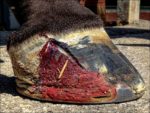Advertise Follow Us
Items Tagged with 'racing'
ARTICLES
Don’t Let Quarter Cracks Slow Your Clients
Understand the pitfalls for better patching of performance horses
Read More
Toe Grabs Up to 4 mm are OK
The Jockey Club’s Thoroughbred Safety Committee modifies its previous recommendation regarding toe grabs, which may lead farriers and trainers to adjust and manufacturers and dealers to scramble
Read More
"Handedness" in Horses
An Australian farrier's observations on side dominance in horses' feet
Read More










